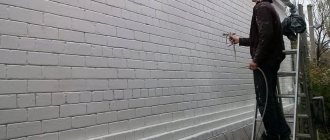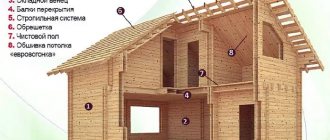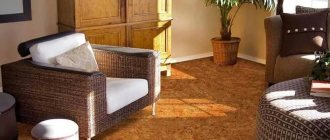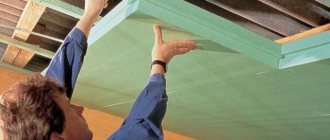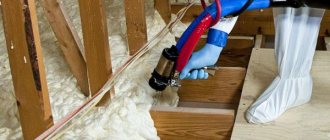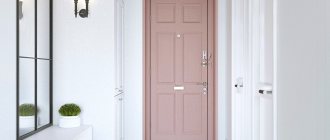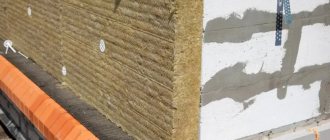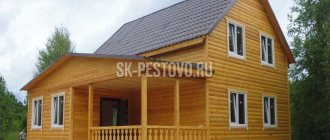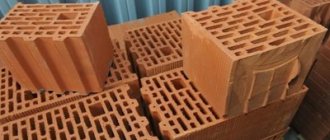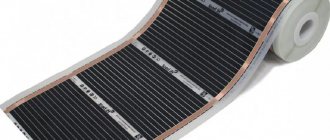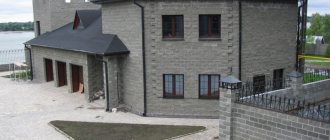When building a house, the most important task is its thermal insulation, the quality and durability of which determines not only comfort, but also heating costs. In suburban housing construction, ecowool is becoming an increasingly popular thermal insulation material, the pros and cons of which will be discussed in detail in this article, along with issues of installation and the feasibility of use on different structures.
Ecowool can be used to insulate almost all parts of the house Source green-agency.ru
Installation of ecowool
Ecowool is sold in compressed bags.
Therefore, before work, it should be fluffed until smooth. When using blow molding equipment for insulation, no preliminary preparation of insulation is required, since the installation itself gives the ecowool the required consistency using tedders. An important point is the choice of material installation method. It is not advisable to lay ecowool on floors with your own hands, since the insulation may settle over time. In addition, this method does not provide one hundred percent filling of hard-to-reach cavities and difficult areas. Proper thermal insulation can only be ensured with the help of special equipment.
This is interesting: the advantages of hardware application of insulation were known a hundred years ago. The first blow molding equipment appeared at the beginning of the 20th century in Germany. The installation was manual. A cart was used to transport it, and there could be no talk of high mobility of the device.
Preparing the base
Insulating the floor in a private country house is not a difficult task at all if you follow some rules. The optimal thickness of the insulating layer should be at least 20 cm. This is enough to minimize heat loss. However, in regions with cold winters, insulation up to 30 cm thick is installed in the floors.
Typically, in private houses, logs are assembled from boards measuring 20x5 cm. The distance between the logs is 60 or 40 cm, depending on the floor covering and expected loads.
OSB sheets or boards treated with an antiseptic are attached to the bottom of the joists to prevent ecowool from shedding. Then, using a stapler, a layer of windproof film is mounted with the rough side up to the heat-protective material. The membrane is laid in rows with a 15 cm overlap.
When insulating an old floor with ecowool, preliminary preparation is also required. Under the structure it is necessary to provide protection against crumbling. To do this, boards or OSB sheets are attached to beams or joists. Insulating material is blown through the holes in the subfloor covering. The size of the holes must be no less than the diameter of the blower hose.
Installation of ecowool using the dry method
For the work, professional equipment is used, which allows you to tightly apply insulation under strong air pressure. Blowing devices ensure uniform application and help avoid shrinkage of the material. If desired, such installations can be rented or specialists can be invited to do the work professionally.
To apply the dry method, the insulation is placed in a special hopper and from there, in a crushed state, is supplied through a hose to the place of insulation. The equipment usually has a valve for dosing the material.
After the insulation procedure, a vapor barrier layer can be provided on top of the heat-protective material. Its installation should be given special attention, since the service life of both the cellulose insulation itself and the wooden floor elements depends on the quality of the joints.
If the task is to insulate floors in a room with high humidity, you can also lay a waterproofing membrane on top of the heat-insulating material.
Wet floor insulation
The second method of insulating floors is wet installation. To do this, moistened insulation is supplied into the space between the joists from the blowing unit. The advantage of this technology is that, due to the lignin included in ecowool, the material adheres better to structures. After drying, the insulation does not come off the surfaces.
For wet application, water and an adhesive solution are used. The liquid is supplied by a pump and mixed with the insulating material. The floor covering should be laid over the insulation only after the insulating material has completely dried.
Insulation thickness
To insulate a floor with ecowool, you need to decide on the thickness of the insulation. We recommend sticking to the following indicators:
- 10 - 20 cm is sufficient thickness for interfloor ceilings. It will not only protect against heat loss, but also provide good sound insulation;
- 20 cm is the recommended insulation thickness for the first floor floor. If homeowners wish, the thickness can be greater, if the design allows.
When insulating the floor using blowing units, there is no need for additional mechanical compaction of the insulation layer. This is possible due to the fact that the material is supplied under high air pressure and is laid down in a dense layer that does not require compaction or refilling.
To determine how much ecowool you will need, use the ecowool calculator. Go to the calculator to calculate the amount of ecowool insulation.
Manual styling
This material can be used for insulation in various ways.
One of them, industrial, consists of spraying pre-moistened ecowool onto the surface requiring treatment using specialized equipment, as well as pumping dry material into the insulated frame with a powerful compressor. In addition, you can install the material manually, but this will increase its consumption. This process will take an order of magnitude longer.
The manual method of installing the material is labor-intensive, increased time costs, and the impossibility of completely filling all existing cavities, voids and cracks. But many people prefer this option, since it turns out to be much cheaper.
If you intend to insulate a shed, outbuilding or garage, follow the given procedure:
- Since the material is in a compressed state, it is necessary to fluff it well. You can do this using a drill and a paint attachment. The fluffed material can begin to be used.
- The briquette with insulation is opened, the mass is poured into any suitable container.
- This method of using the material can only be used for filling it into floors (when laying it from above), or for dry laying it into a wall space.
- When filling into floors, the mass should be evenly distributed between the joists and rafters. It is used to fill all the required places until a surface with a slide is formed. When the floorboard is subsequently used, the material will be compacted to the required volume.
- When dry filling the mass into vertically located structures, it should be carefully compacted: the density of the material should become only two times less than the original one inherent in the factory briquette.
Advantages of ecowool insulation
In addition to environmental safety, ecowool has many more advantages:
- Has high sound insulation properties;
- Sticks well to any surface: stone, wood;
- Does not shrink after installation using a blow molding installation;
- Retains thermal insulation properties even at 20 percent humidity of the material;
- Has the ability to release moisture;
- Eliminates the appearance of cold bridges, thanks to the hardware filling of all hard-to-reach areas;
You can work with ecowool under different temperature conditions. The level of humidity in the room also does not play an important role when installing insulation.
What to look for when choosing ecowool for the floor
Insulating the floor with ecowool may not bring the desired result if you purchased products of unknown origin. Pay attention to the properties of the material. It must meet the following characteristics:
- High-quality insulation is similar in appearance to down;
- When touching ecowool, you should not feel damp;
- There are no large pieces of newspaper in the mass;
- When set on fire, the material smolders without igniting and goes out;
- Ecowool color is grey. The yellowish tint of the insulation indicates the use of low quality raw materials;
- Ecowool with high-quality fibers does not shed mineral salts.
We recommend choosing a trusted manufacturer with many years of experience in the market of thermal insulation materials. GreenWool produces high-quality and reliable cellulose-based insulation, whose plant is located in Kanash, Chuvash Republic. The material is produced on equipment with automated dosing of components, which ensures stable quality of ecowool.
This is important: familiarize yourself with the composition of the insulation. Apart from cellulose, borax (sodium tetraborate) and boric acid, it should not contain any other components. The presence of ammonium sulfate should alert you: such insulation emits an unpleasant odor for a long time, and the floor insulated with it will quickly lose its heat-protective properties.
Minvata
Mineral wool is one of the most common types of insulation for insulating various elements of a building, that is, insulation is laid in the roof, floor and interior floors, floors, walls, both inside and outside the room. Tiled or rolled mineral wool allows you to quickly insulate a house, bathhouse, and various utility and non-residential premises.
Such popularity of mineral wool is easily explained by the wide selection of varieties, brands, and availability in retail chains. Also low cost, ease of installation, high heat and sound insulation characteristics. But there is another side - a negative one, which sometimes outweighs all the positive qualities of many varieties and brands of mineral wool. The use of formaldehyde resins as a binding component to form an insulating layer significantly reduces its environmental friendliness, but reducing the component reduces the moisture resistance of the finished insulating material. Only some types based on basalt fiber do not contain harmful toxins. In its pure form, it is difficult to impart the required density to mineral wool; there remains a risk of dust from mineral fibers getting into the air of the insulated room, so it is mainly produced in rolls or mats with already formed density and rigidity.
Advantages of mechanized insulation
Professional equipment is used to insulate the floor with ecowool. The operator smoothly moves the sleeve, ensuring uniform application of ecowool.
Mechanized installation has a number of advantages compared to manual installation:
- Manual labor for carrying material to insulated structures is eliminated;
- The blowing machine fills all hard-to-reach areas and crevices with material;
- A layer of insulation without seams, differences in thickness, with uniform density;
- Thermal insulation does not shrink due to the high density of the layers.
This is interesting: the process of insulating an ecowool area of 100 m², 20 cm thick, manually takes approximately two days. Continuous installation using blow molding equipment lasts 2.5 hours.
To make floor insulation with ecowool as effective as possible, use a professional that not only produces GreenWool insulating material, but also carries out installation using specialized equipment.
The insulation process is not limited to simply applying material to the surface. This also includes a set of related works:
- Assessment of the condition of the object;
- Recommendations to the customer on choosing the method of installing ecowool, the optimal layer thickness, taking into account the specifics of the design;
- Selection of insulating materials to provide protection against moisture penetration into the insulation: steam and waterproofing membranes.
The installation of ecowool on site is carried out by a team of two operators. Our specialists have been trained to work with blow molding machines and have at least 20 years of experience in this field.
Insulation of floors with ecowool is carried out using imported equipment with a productivity of up to 1270 kg per hour, depending on the volume of work. For effective and high-quality thermal insulation, the machines are equipped with additional accessories: hose attachments, adapters, nozzles. This allows you to insulate complex structures and hard-to-reach places.
Professional installation using specialized equipment will guarantee high energy efficiency of a home, industrial facility, administrative building, or other facility.
Furniture flock: advantages and disadvantages
Flock is produced by applying pile to the base. The optimal fabric composition in terms of quality and price is a polyester and cotton base (65% and 35%) and nylon pile. What properties does flock have?
- -One of the reasons why flock is used for furniture upholstery is the absence of snags. No matter how hard the cat tries, the warp will not fall apart on a thread.
- -Pleasant to the touch. Upholstery flock is as soft as velvet, but much more practical and affordable.
- -Externally, the material amazes with its beauty
- -Long service life
- -Affordable cost of material
- -Large assortment due to the ability to dye fabric, make drawings, embossing
- -Good dirt-repellent properties due to the inclusion of nylon pile in the material
- -Easy to clean: it can be washed, following certain rules.
- -Can be ironed, but only from the wrong side, ironing temperature 100° C.
The disadvantages of flock include its fear of alcohol, since it can dissolve the glue that holds the fibers. Since glue was used in production, you should be careful when caring for the fabric:
- -You cannot straighten the stuck together fibers; you can tear them off from the base.
- - Furniture flock should be cleaned with a fabric brush
- -Stains should be removed immediately as they appear, without allowing them to soak in
- -The use of steam cleaners and hair dryers is contraindicated
- -You can wash, you just need to do it correctly: delicate wash at a temperature of no more than 40° C, zippers fastened, refusal to use bleach, choosing a solution of liquid soap as a detergent.
- -You need to wash it carefully, as stains may remain on the fabric.
- -Flock furniture fabric is electrified during use, which helps attract dust to the surface of a sofa, armchair, etc.
- -Under constant load, the fabric wears out, so we do not recommend using it on sofas or armchairs that are used as a sleeping place
- -Absorbs odor
When flock is coated with a Teflon compound, a more durable material is obtained that erases some imperfections. This fabric is called Teflon flock or courtesan.
When comparing all the pros and cons, it becomes clear that flock is an affordable and practical material that is in demand when upholstering furniture.
Rules for installing floor insulation on joists using ecowool
- Registration: 01/22/17 Messages: 2 Thanks: 0
knbelov
Newbie
Registration: 01/22/17 Messages: 2 Thanks: 0
Rules for installing floor insulation on joists using ecowool
Good day!
In the summer I want to insulate wooden floors in my dacha, I think I will insulate them with ecowool - as it is the most environmentally friendly. I can’t find the correct insulation technology anywhere.
What kind of pie should there be when insulating wooden floors along joists using ecowool.
Is a vapor barrier needed on the side of the room, what should the subfloor be made from, what should be placed under ecowool, is there a need for a ventilation gap between the finished floor and the insulation. What is the classic method of insulating floors with ecowool. Experts, please share!
- Registration: 01/26/17 Messages: 79 Thanks: 22
AlexanderN20
Blocked
Live here
Registration: 01/26/17 Messages: 79 Thanks: 22
Think so. Bromine is banned in Europe as hazardous to health (it reacts in compounds to form harmful substances), and cellulose is very hygroscopic, and even made from garbage. If you want to turn your house into a landfill, do it.
If you think about it, why “ecowool” is not certified in Russia, what are the reasons? Then everything becomes even more clear.
- Registration: 01/22/17 Messages: 2 Thanks: 0
knbelov
Newbie
Registration: 01/22/17 Messages: 2 Thanks: 0
I have finally decided - vermiculite is expanded, I don’t see any other options
- Registration: 04/30/12 Messages: 33 Thanks: 10
Ecovataprofi
Participant
Registration: 04/30/12 Messages: 33 Thanks: 10 Address: Moscow
Don't scare or confuse people! all information on the composition, certification and production of ecowool is publicly available on the Internet. You make a dump in people's heads. Everyone has a choice of how to build and how to insulate their home.
- Registration: 08/29/12 Messages: 4 Thanks: 3
AsiaAl
Newbie
Registration: 08/29/12 Messages: 4 Thanks: 3 Address: Syktyvkar
I insulated the floors with ecowool. I installed it myself.
The logs are 100*180, lined with inch boards at the bottom. I laid craft paper over them. I divided the ecowool bag into several parts, poured it into other bags and beat it with a screwdriver with an attachment for mixing solutions. Then I scattered it and covered it again with paper. Consumption on a horizontal surface of 3.85 m * 0.59 m * 0.18 cm - 1 bag of 15 kg.
We moved into a house under construction without planning and we didn’t have time to make the hatches to the basement properly, we just covered them with 15 cm stone wool. All winter I walked barefoot on the floor - it was comfortable. But the hatches into the basement with stone wool insulation were noticeably cooler.
And yet, there was a moment when the heating system was started, water flowed under the plywood onto the insulation. We didn't notice it right away. The floor was raised in a few days. The insulation was damp, but did not sag. They took it out, dried it and put it back in place. Its characteristics have not changed.
We have wintered like this for one winter so far. It was cold outside, about 40 degrees.
- Registration: 08/09/14 Messages: 54 Thanks: 5
Enotishche
Participant
Registration: 08/09/14 Messages: 54 Thanks: 5
There's kraft paper on the bottom and you didn't put a vapor barrier on top? After winter, didn’t you check the ecowool for getting wet?
- Registration: 08/29/12 Messages: 4 Thanks: 3
AsiaAl
Newbie
Registration: 08/29/12 Messages: 4 Thanks: 3 Address: Syktyvkar
Sorry it's late.
Bottom and top are kraft paper without vapor barriers. No getting wet. The floors have been very warm for two winters already.
Is vapor barrier necessary?
A vapor barrier protects the insulation in a wall or roof from vapors that escape from the house. Warm air, meeting cold air, condenses at the dew point, which usually falls right on the insulation. As we have already figured out, moisture does not have the most favorable effect on thermal insulation material. You can often come across the opinion that when insulating with ecowool, a vapor barrier is not needed. This is not entirely true, because moisture may not damage the insulation itself, but will cause rotting of other structural elements (walls, sheathing, etc.).
What is ecowool
Ecowool (ecological wool) is an insulation material made from cellulose fiber (from waste paper). Thanks to this, the fibers absorb moisture well (up to 14% of the volume) and release it just as well. Cellulose is a “breathable” material; it allows air to pass freely, like regular wood.
Ecowool can be purchased in briquettes
Main characteristics:
- thermal conductivity coefficient - 0.04;
- vapor permeability - 0.3 mg/m*h*Pa;
- flammability - group G1 (lowly flammable);
- smoke generation - group D2 (moderate smoke generation ability).
Ecowool is pressed cellulose fibers, waste from the paper industry. Externally, it is a loose mass of light gray color. Packaged in bags or briquettes of 5-15 kg.
Doesn't burn or doesn't support combustion?
Flammability is a parameter that you need to pay close attention to; the overall fire resistance of the entire building depends on it. According to GOST, there are 5 flammability classes: NG (non-flammable), G1 (low-flammable), G2 (moderately flammable), G3 (normally flammable), G4 (highly flammable).
Ecowool does not support combustion, so fire does not spread into the material
Based on the results of comparing flammability classes, ecowool cannot be called the most fire-resistant material. It should not be used near chimneys, stoves or fireplaces.
Pros and cons of insulating floors with ecowool
Ecowool as floor insulation has a wide range of advantages:
- durability: service life even in frosty climates up to 50-60 years;
- optimal microclimate: quite warm in winter, cool in summer;
- practicality: ecowool does not grow mold, it is not spoiled by rodents;
- additional sound insulation: the layer absorbs noise;
- non-flammability;
- ease of transportation and installation;
- the layer lays down tightly and does not cake during use;
- material consumption is small;
- Insulation using the dry method is carried out in any weather.
But this material also has disadvantages:
- Quite expensive.
- To carry out insulation, you may need additional equipment (a mixer or a drill with a special attachment, as well as a unit for mixing with water or glue, an electric scraper).
- It can smolder, so when insulating floors next to a fireplace or stove, it is necessary to install an additional covering made of fireproof material.
- Low rigidity, which is why insulation cannot be started without first installing the floor frame. Many other insulation materials also have this disadvantage.
- If insulation is done using a wet or wet-adhesive method, such work can only be carried out at positive temperatures.
Ecowool floor insulation is one of the most durable options
Application area
Ecowool can be used for insulation with the same effect:
- facades - applied to the sheathing using the wet method;
- walls - when laying using the “well” method;
- walls from the inside of the room - dry or wet on a pre-prepared lattice;
- attics and roofs - performed using the dry blowing method;
- floors - insulation is carried out using the dry method, followed by covering the heat-insulating layer with plywood or OSB sheets;
- attics - roof insulation with ecowool is carried out by dry blowing. The floor can be insulated manually.
Attention: cellulose fiber wool cannot be used under floating floors or screeds.
How to insulate a floor with ecowool
The material is laid manually and automatically. Each of them has its own characteristics, and equipment will be needed in any case, since cotton wool requires fluffing.
Manual method
The manual method of insulating a floor with ecowool involves the following steps:
- Measure out the required mass.
- Place ecowool in a large bucket or box (up to a third of the container’s volume).
- Fluff it with a drill with a special attachment - after this the volume will increase three times. You can use a mixer instead.
- Pour the material into the floor covering. Level the surface layer.
The manual method of insulating a floor with ecowool is quite simple and does not require special skills. But it is only suitable for small areas, such as a kitchen, room or hallway of a typical sized house.
Automated method
An automated method of insulating floors with ecowool is used in cottages and large houses. It would be more correct to call it semi-automated, since the work is done manually, using special equipment:
- An automatic blowing machine that turns the ecowool and distributes it evenly.
- The hoses are corrugated plastic, through which fluffy insulation is supplied.
- Pumps (useful in case of water-adhesive installation).
- Blowing nozzles, trimming rollers, which are used to remove excess material.
General principles of thermal insulation
The correct technology for thermal insulation of floors consists of five main stages:
- dismantling old floors;
- installation of rough (technical) floor;
- laying insulation and securing it;
- laying a hydro-vapor barrier over the insulation;
- installation and securing of the finished floor.
Each specified stage must be carried out with the utmost care. If errors are made during the installation process, correcting them may require large amounts of time and money. Therefore, it is not recommended to carry out work without prior preparation, in a hurry and without due care.
Methods for insulating floors with ecowool
Insulation of wooden floors with ecowool is carried out in several ways: dry application, wet and wet-adhesive (water and glue are used).
The manual method of floor insulation is accessible to everyone
Dry application
The dry method of insulating a floor with ecowool does not involve wetting it with water or an adhesive solution. This option is used for both floors and vertical structures.
Algorithm of actions:
- Waterproof the rough concrete floor. To do this, use roofing material, plastic film or other material.
- Install wooden logs at intervals of 60 cm (according to the size of the ecowool briquette). If the floor is not concrete, then the logs are placed on posts, and the bottom side is covered with plywood or boards - as a result, a box is created, which will be filled with ecowool for insulation.
- Pour ecowool into a container (boxes, bucket) to a third of the volume.
- Fluff using a mixer or drill with a special attachment.
- Pour the resulting mass between the joists so as to slightly exceed their level (by 2-3 cm).
- Moisten the surface with water by spraying it from a spray bottle (moistening should be light).
- Upon completion of the work, the surface layer is compacted. But it is not recommended to compact it too much, since this will deteriorate the thermal insulation qualities of ecowool.
Attention! The disadvantage of the dry method of insulating the floor with ecowool is that the work is accompanied by heavy dust. Therefore, it is necessary to wear a respirator and goggles.
Wet application
Wet application of ecowool for floor insulation involves pre-treatment of the material with water. This method has a number of advantages:
- good adhesion of the material to the surface;
- uniform and dense laying creates the required layer of thermal insulation;
- durability - a layer of ecowool on the floor will last for several decades;
- you can quickly cover any area, which is especially important for large houses.
The instructions are:
- They install blowing equipment and fix corrugated hoses.
- Pour ecowool into the bunker.
- At the outlet, a container is attached from which water will be supplied (using a special pump).
- Includes installation. She wets the ecowool, foams it and delivers it to the desired height.
- At the end of the work, cut off the excess material using an electric scraper.
- The surface is left to dry for 2-3 days. To ventilate, the window must be opened in advance so that during this entire time there is no contact with the floor.
- After this, linoleum or other finishing material is laid.
When insulating the floor using the wet method, raw materials are supplied through a pipe
Work should be planned for the warm season.
Attention! The wet method of applying ecowool for floor insulation is not used at subzero temperatures.
Wet-adhesive application
The technology of this method is not fundamentally different from wet application of ecowool. However, not only water is added to the solution, but also glue, which is used as PVA. The work is also carried out in the warm season - at low temperatures the material will not lie down and will be deformed.
The advantages of this method are obvious:
- dust-free work;
- thanks to the glue, the material becomes elastic and more durable;
- after drying, the insulation does not deform;
- the material lasts for several decades;
- cotton wool adheres to the soil even better than when applied with water;
- You can work on any surfaces, including metal;
- effectiveness of the method. It is possible to cover even large areas in a relatively short time.
Use as bottle insulation
Absolutely any types of bottles are suitable as insulating material, but it is worth noting that they can be used for floors with light loads, for example, in a bathhouse. The operating principle of this insulation method is based on creating an air cushion using bottles.
Floor insulation with bottles is carried out according to the following algorithm:
- Preparing bottles involves heating them and then sealing them with lids (it is advisable to fill glass bottles with bulk material).
- A reinforcement mesh is installed on top of the soil base of the floor.
- The bottles are stacked (so that the necks are directed towards each other).
- The stacked bottles are filled with concrete (if necessary, in several layers).
How to calculate the amount of ecowool for the floor
Floors require a minimal amount of material compared to walls and other surfaces. Standard consumption is 35 kg/m3. To determine how many cubic meters will be filled, it is necessary to make a simple calculation taking into account the area and height of the thermal insulation layer.
For example, if you need to cover an area of 25 m2 with a layer of 20 cm (reliable thermal insulation, including for frosty winters), then 25 * 0.2 m = 5 m3. Knowing the consumption rate of 35 kg per 1 m3, we obtain: 35*5 = 175 kg. Thus, for a floor area of 25 m2 you will need 175 kg of raw materials. If one briquette contains 15 kg, you need to purchase 12 pieces.
Calculation of the amount of insulation and the density of its layer
When insulating the floor of interfloor ceilings, it is necessary to remember that the thickness of the layer of material should be 10-20 centimeters, and for the lower and upper floors - 20-30 centimeters. Density with manual open filling is 30-35 kg/m3, with mechanical blowing into a closed cavity - 40-45 kg/m3, and with mechanical open application the density is 35-40 kg/m3.
The mechanical method of blowing ecowool (between the joists) makes it possible to guarantee that the entire internal space of the floor is filled without leaving seams in it. This method allows you to achieve the optimal density of the ecowool layer and give it maximum thermal insulation characteristics.
Rules for applying ecowool to the floor
When using ecowool for floor insulation, certain rules must be followed:
- If you work in the traditional manual way, the consumption increases by 15-20% compared to the automated option. This must be taken into account when purchasing raw materials.
- The recommended height of insulation for the floor is 15-20 cm: this is quite enough for the attic.
- When calculating, the volume is increased in advance by 5-10%. A small margin must be left for shrinkage. If this is not done, voids will form in the floor and the thermal insulation will deteriorate significantly.
- If you use the wet or glue method, it is better to invite professionals, since in this case skills in working with equipment are required.
The optimal height of the insulation layer is 15-20 cm
Briefly about the main thing
The very name of ecowool hints that it is an environmentally friendly and harmless insulation material. In fact, one can argue with this statement, as well as with the fact that this is one of the cheapest and most effective thermal insulation materials.
But when compared with expanded polystyrene or mineral wool, it actually has many impressive advantages, in particular - excellent heat capacity, vapor permeability, resistance to harmful biological factors, and a high degree of sound insulation.
Disadvantages can be found in any material, the main thing is that they are not critical and can be leveled out by following the installation technology. In this regard, ecowool is a very worthy insulation material.
Choosing ecowool for the floor
The basis of any ecowool is recycled cellulose. However, additives may be different. The best option is borax (sodium tetraborate salt). But instead they can add phosphate or ammonium sulfate. You should definitely not buy such insulation, since over time it will release ammonia, polluting the air in the house.
Also, when choosing, you need to inspect and test the raw materials:
- appearance: homogeneous structure, all components are the same, reminiscent of fluff;
- plain color, grey;
- if you set fire to the “fluff”, it begins to smolder (does not burn), and if you leave it, it quickly fades;
- whole packaging;
- trusted manufacturer (good reviews, well-known brand).

